I decided to read and complete “The Artist’s Way” program. This is my very first week of it and I wanted to let you all in on the journey.
What is the Artist’s Way?
“The Artist’s Way” is a book by Julia Cameron. It is also a 12-week course designed to help people recover their inner creativity and overcome creative blocks.
The book aims to guide readers through a process of creative recovery, using various tools and exercises to unlock their artistic potential.
The two main tools introduced in the book are:
- Morning Pages: Three pages of longhand, stream-of-consciousness writing done first thing in the morning.
- Artist Dates: Weekly solo outings to explore and nurture your inner artist.
Chapter One, “Recovering a Sense of Safety,” is the chapter I read this week and the topic of today’s blog post.
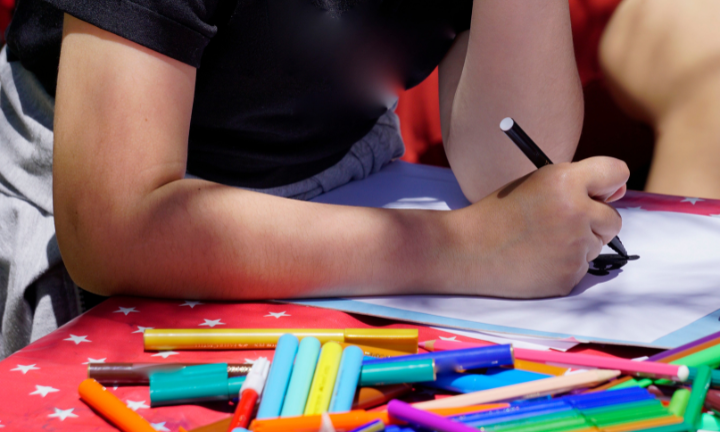
Why the Artist’s Way?
Recently I have gotten into drawing. I eventually want to be able to sit down and draw anything, but I still have a long way to go before I get to that level. A few weeks ago I was looking up videos on YouTube on how to draw better and how to be more creative.
This video popped up in the feed and I pressed play. It was awesome. (I recommend watching so this makes more sense.) I didn’t exactly know what the guy was talking about when he talked about “The Artist’s Way”, but it sounded cool.
As soon as I finished that video more videos followed. Videos of people being so grateful for this book and the impact it had on their lives. Some cried. “Completely life-changing” was a repeated phrase. YouTube kept recommending videos about “The Artist’s Way.”. And I kept watching.
It didn’t take too many videos of people swearing by “The Artist’s Way,” to have me convinced. I bought the book on Amazon, and an accompanying “Morning Pages” journal, and decided I would start this week. You can buy the main book here and the morning pages journal here.
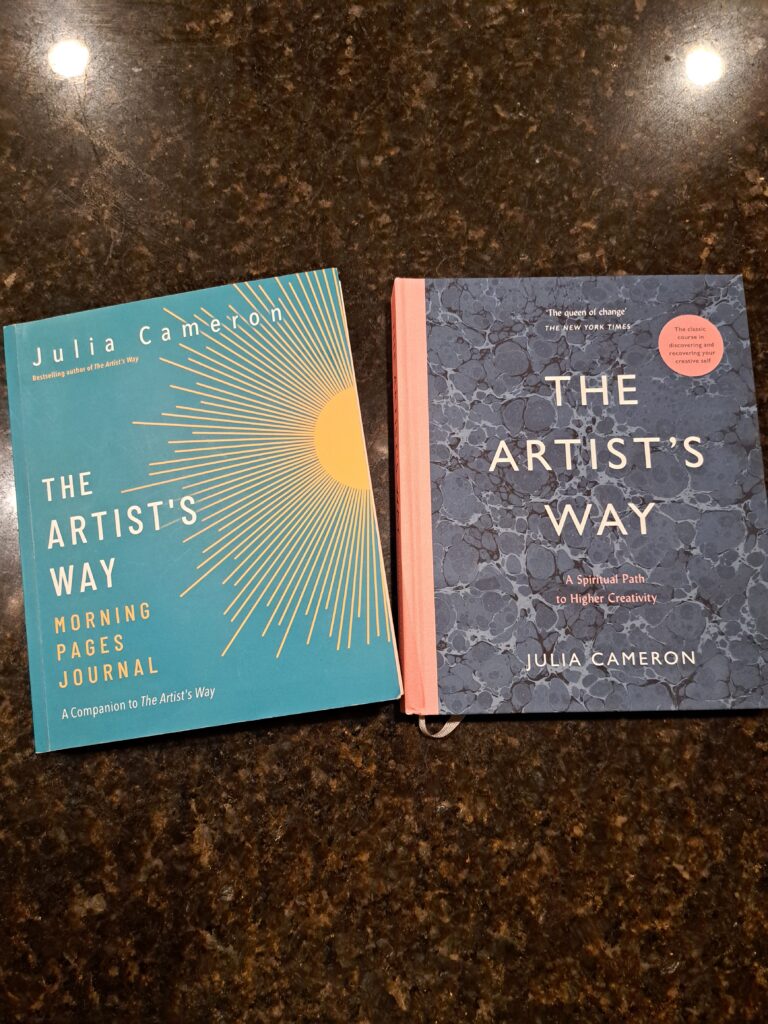
So… the book helps you be more creative?
The Artist’s Way by Julia Cameron is more than just a book; it’s a comprehensive 12-week program designed to help individuals unlock their creative potential and overcome the barriers that inhibit their artistic expression. The purpose of the book is to guide readers through a process of creative recovery, helping them to rediscover and nurture their inner artist.
Purpose of the Book
The primary aim of The Artist’s Way is to help people reconnect with their creativity, regardless of their artistic background or current level of creative engagement. Julia Cameron believes that everyone has inherent creativity, but various factors—such as self-doubt, criticism, and life responsibilities—can stifle this natural talent. The book provides tools and exercises to help readers:
- Identify and Overcome Creative Blocks: By recognizing the negative beliefs and experiences that have hindered their creativity, readers can begin to dismantle these obstacles.
- Build a Supportive Environment: The book emphasizes the importance of creating a safe space for creative exploration, free from judgment and criticism.
- Develop Consistent Creative Habits: Through practices like Morning Pages and Artist Dates, readers establish routines that nurture their creative selves.
- Foster a Positive Mindset: Affirmations and other exercises help to replace negative self-talk with supportive, encouraging thoughts.
What the Book Actually Does
The Artist’s Way employs a variety of tools and exercises to achieve its goal of creative recovery. Here are some of the key components:
- Morning Pages: This daily practice involves writing three pages of stream-of-consciousness thoughts first thing in the morning. It helps clear mental clutter, process emotions, and unlock deeper creative ideas.
- Artist Dates: These weekly solo outings are designed to nurture and inspire your inner artist. By dedicating time to activities that delight and inspire you, you feed your creative soul and keep your artistic energy vibrant.
- Weekly Exercises: Each chapter includes tasks and exercises that encourage self-reflection and creative experimentation. These activities help readers to confront and overcome their creative fears and blocks.
- Affirmations: Positive affirmations are used to counteract negative beliefs about creativity. By regularly affirming their creative potential, readers build a more supportive and encouraging mindset.
- Creative Exploration: The book encourages readers to explore different forms of artistic expression, whether it’s writing, painting, music, or any other creative pursuit. This exploration helps to expand their creative horizons and discover new passions.
In essence, The Artist’s Way serves as a guide and companion for anyone looking to reignite their creative spark. It provides practical tools and a structured approach to help readers overcome their creative blocks, build supportive habits, and ultimately, live more creatively fulfilling lives.
My expectations for the Artist’s Way book
I’m not totally sure what to expect. That “So… the book helps you be more creative?” heading up there wasn’t me trying to ask a question I think you as the reader might have. That was one of the genuine questions I had at the beginning.
I don’t have a ton of expectations for the book mainly because I don’t know what I am getting into. I can think of two things I want to get out of the book.
First, I want to improve my drawing skills. If not being able to draw anything by the end of this 12 weeks, at least improve greatly in my drawing. Second, I have been working on a poetry book (about creativity, oddly enough) and want to finish it within the next 12 weeks so I can move on to the publishing phase.
Those are my two goals and expectations. There is no other expectations going in to this. Many of the testimonial videos I watched talked about how the Artist’s Way book helped them in so many aspects of life, not just creativity. That would be cool, but I am going in with just the two expectations. It will be fun to see what happens.
For the next twelve weeks, I will be posting an article per week, on what I thought of that week in the program – on Saturdays or Sundays.
Here is where my drawing skills are right now. I will update you all on where my drawing level is at each week and poems I am writing.

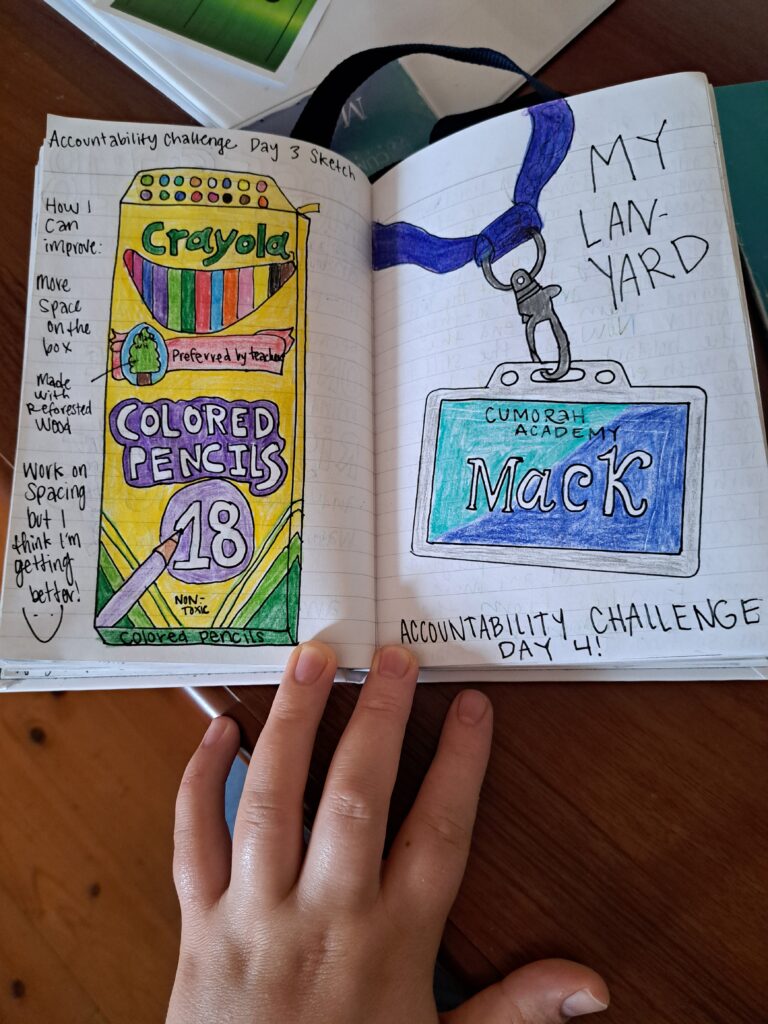
Chapter One of the Artist’s Way: Recovering a Sense of Safety
Chapter One of The Artist’s Way by Julia Cameron is titled “Recovering a Sense of Safety.” This chapter sets the foundation for the creative recovery process by addressing the fears and negative beliefs that often block creativity.
One of the first things that struck me was the emphasis on identifying and confronting the negative thoughts we carry about our creativity. Cameron encourages us to reflect on the critical voices we’ve internalized—those comments from parents, teachers, peers, or ourselves that made us doubt our abilities. I realized how much these beliefs have impacted my own creative journey.
Chapter one and the introduction mostly talked about how the book works. What the morning pages and Artist’s Date are (I’ll get to that in a minute,) and allowing yourself to be creative by getting rid of those negative thoughts and beliefs that our inner artist has internalized, and that have been damaging.
One of the main ways to do that is through morning pages.
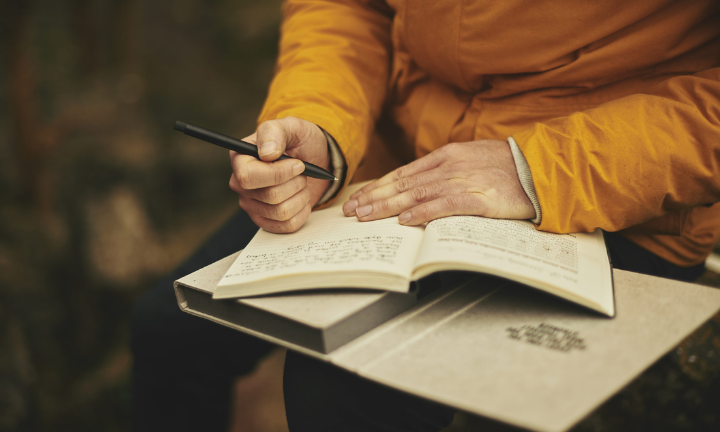
What are morning pages?
This is an important section because morning pages are the backbone of the Artist’s Way. I signed a contract at the beginning of the book stating I will complete my morning pages every day and my artist’s date every week. Those both are “non-negotiable” as the book puts it.
Morning pages are three pages you write in the morning. I bought the morning pages journal to use for the morning pages, but you could just use any notebook. (That honestly might be better because the morning pages journal is BIG and you have to write A LOT!)
The first thing you do in the morning upon waking up is write your morning pages. Three full pages.
About what? You may ask. Good question. About anything. It is a stream of conscious writing, clearing your mind and getting any clutter out on the paper. Doing the morning pages right in the morning can help you prepare for the day ahead. All the random thoughts and to-do list items can get down on the paper and out of your head.
What if I don’t have anything to write? Another great question. If you have nothing to write, write “I have nothing to write” for three full pages. Non-negotiable.
Morning pages are not to be shared. They’re not even meant to be looked back over. They are messy. You are not writing something for the world. You are just clearing your head of the clutter. It’s a healing process. As a writer, I was specifically told NOT to worry about “writing” my morning pages. Don’t worry about grammar or spelling mistakes.
You will have lines that don’t make sense. You will have misspelled words and uneven handwriting. You might have a few pages that are just angry ranting about something. And that is okay. You are clearing your head, not making a perfect masterpiece.
Nobody is going to read your morning pages. DON’T write for anyone else’s eyes. Morning pages are for you and you alone. Be honest.
Julia Cameron says, “Morning Pages are the primary tool of creative recovery. These daily, stream-of-consciousness writings are not meant to be art. Or even writing… They are simply a tool, useful not just for writers but for all artists and anyone looking to deepen their creative experience.”
Then, later in the chapter, “Each morning, as we face the page, we meet ourselves. The pages give us a place to vent and a place to dream… Pages clarify our yearnings. They keep an eye on our goals. If we are drifting, the pages will point that out. They will point the way true north.”
Don’t edit the page. Just get it written down, first thing in the morning. And it has to be written, not typed.
Morning pages examples
Here are a couple of my morning pages from this week to give you an example.


You can see that my handwriting is not very nice. I wasn’t trying to make it pretty. And, it was a rather simple entry. I had watched the movie “Divergent” the night before so that was on my mind, and then I wrote out my to-do list. You are NOT making something pretty. This is not a journal in that sense.
The next day was harder to come up with things to write about:
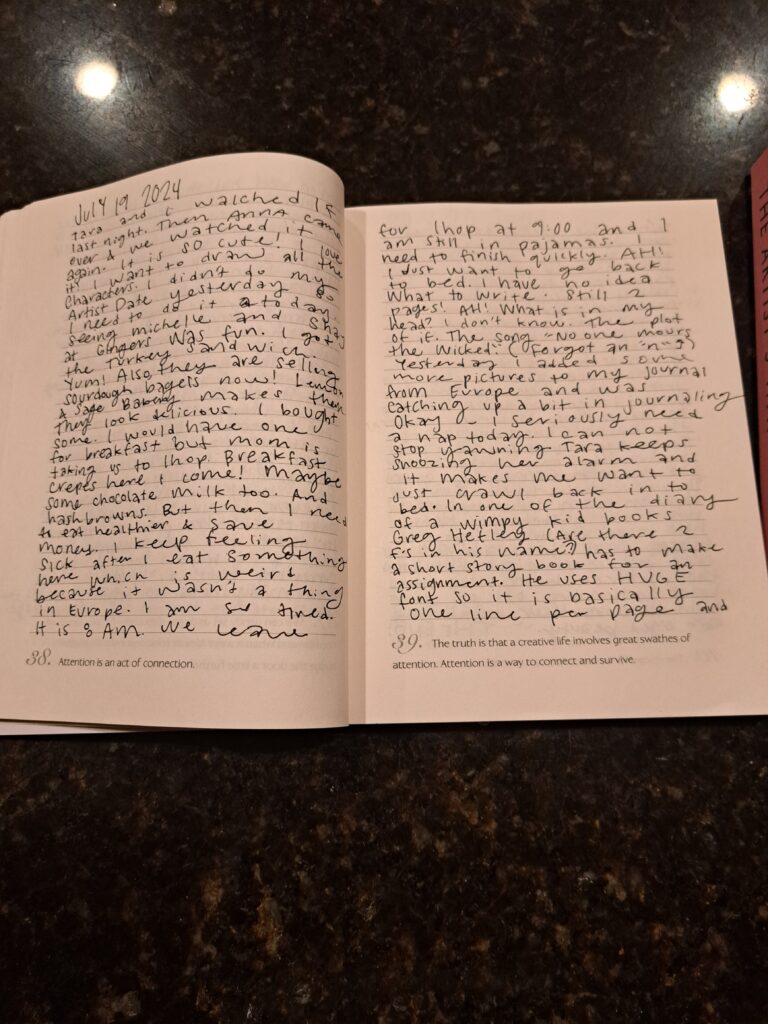
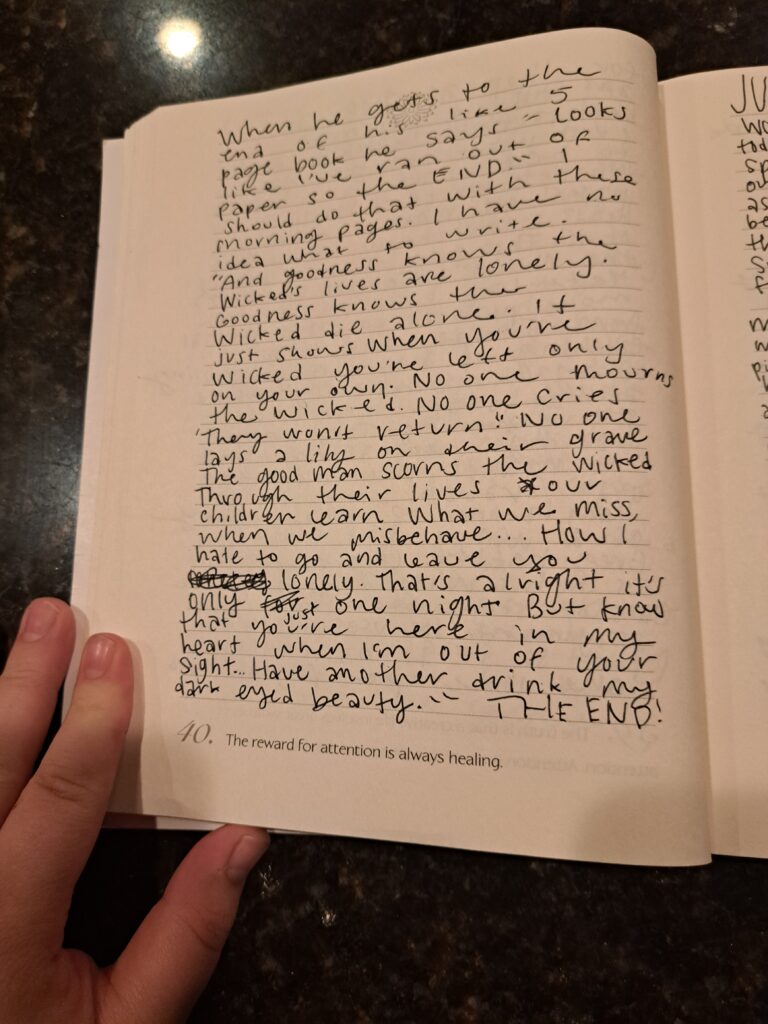
That is even messier handwriting than the first one, and almost a whole page is dedicated just to lyrics that were stuck in my head that morning.
Writing my first few morning pages I was nervous I was doing them wrong. Did they need to be specifically about art and creativity? Did I need to include something or write a certain way?
The answer is no. It doesn’t have to look a certain way. It doesn’t have to be about art. Write about whatever. It doesn’t matter. Just write. Write three pages every morning.
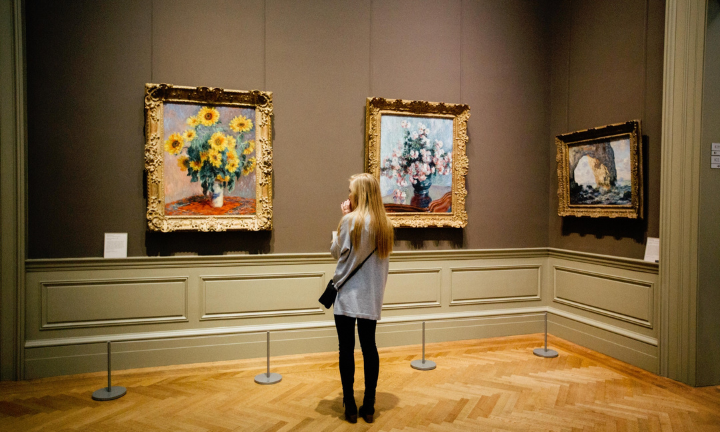
What is the Artist Date?
The second non-negotiable is called an Artist Date.
Julia Cameron explains it, “An Artist Date is a block of time, perhaps two hours weekly, especially set aside and committed to nurturing your creative consciousness, your inner artist.”
Once a week you must go do something for your inner creativity, just you. Keep it solo and don’t let anything get in the way. This is precious time. Julia Cameron warns you in chapter one that people and life will try to encroach on, interrupt or join your Artist Date. Don’t let them.
This week for my Artist Date I turned on some music and scrapbooked about my recent trip to Europe. It was nice. At least half, if not more, of your Artist Dates are supposed to be outside. For week 2, I would love to go to the art museum.
The point is to be comfortable being alone, and to go feed your inner artist.
Julia Cameron’s Spiritual Perspective
Julia Cameron uses the term “The Creator” when talking about the force that drives our creativity. For her, creativity is a spiritual path, and she often frames it as a divine gift. Cameron believes that by engaging in creative practices, we connect with a higher power, which she refers to as “The Creator.”
I agree wholeheartedly with Cameron and do want to make that clear from week one. I believe creativity is a way to honor and serve God, and it is something given to us by God. He is a creator, and as His children, we are creative by nature. We have that desire to create from Him.
One of my favorite quotes from the introduction said, “Those who speak in spiritual terms routinely refer to God and the creator but seldom see creator as the literal term for artist. I am suggesting you take the term “creator” quite literally. You are seeking to forge a creative alliance, artist-to-artist, with the Great Creator. Accepting this concept can greatly expand your creative possibilities.”
Not everyone will agree with that, and that is okay.
For Those with Different Beliefs
If you don’t share this spiritual view, The Artist’s Way can still be incredibly valuable. The principles and exercises in the book are designed to unlock creativity, regardless of one’s spiritual beliefs. You can think of “The Creator” as the universe, a higher consciousness, or simply the creative force within yourself. The practices of Morning Pages and Artist Dates are effective tools for self-discovery and creative growth, whether you view them through a spiritual lens or not.
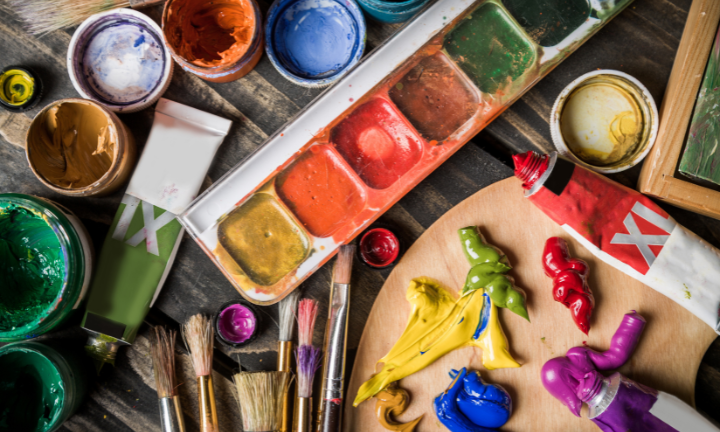
Favorite Quotes from Chapter One:
“We must learn to let our creativity out despite the fear of it being imperfect or wrong.”
“The need to be a great artist makes it hard to be an artist. The need to produce a great work of art makes it hard to produce any art at all.”
“The act of making art is both scary and healing. Art brings light to places that have remained dark.”
“Setting skepticism aside, even briefly, can make for very interesting explorations.”
“The quality of life is in proportion, always, to the capacity for delight.”
“Progress, not perfection, is what we are asking of ourselves.”
“It’s impossible to get better and look good at the same time.”
Tips for Week One in the Artist’s Way
- Do the tasks at the back of the chapter
There is a list of tasks at the end of the chapter that will help you to unleash your creativity. It is suggested to do half of them at least, but unlike the morning pages and artist date, these tasks are negotiable. I had a family reunion this week, and felt too busy to complete ANY of the tasks. I want to do as many as I can because I want to get the most out of this book.
- Schedule the Artist Date for earlier in the week
Otherwise, things will pile up and you will have trouble finding time for it.
Final thoughts on the Artist’s Way?
I liked week one. My book is marked up a lot already. I like the morning pages so far, but I do not really see a huge difference yet. It has only been a week and I wouldn’t know what differences to look for. I am excited to embark on this journey and see where “The Artist’s Way” takes me!


For the record, I love your handwriting. It matches your personality. Big, bold, outgoing and super friendly. It makes me so happy when I see it…like a visual hug!
So excited to watch you progress through this journey!!
Aw! Thank you!